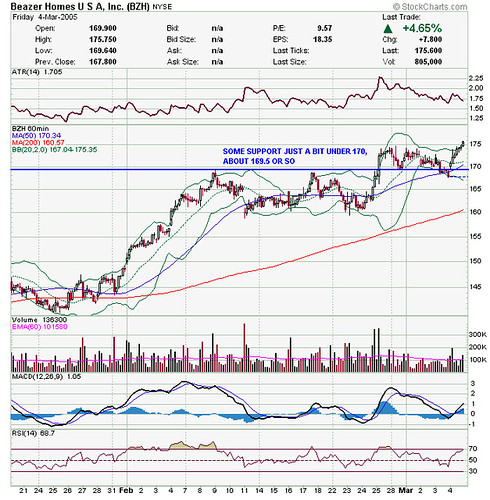On my Loser List for March 3, I said BZH might be a long, if it showed some strength, with a stop about 170. On the 4th, I bought after it had risen above 171. I looked at the chart a little more, and got a little spooked by the daily ATR, or average true range of 5, which basically means that 50% of the time, the stock's movement from high to low is >5 points. I thought, jeez, if I put my stop at 170, I'm gonna get stopped out for sure--so I put my stop at 168. Well, you know what happened--BZH went down to just below 168, stopping me out just above the low of the day, and then on Friday climbed to over 175.
Now, this is NOT a bad trade because it was a losing trade. It's not a bad trade because I essentially bought near the high and sold at the low. It's not even a bad trade because it ran down to my stop, then turned around and rose above my buy point. No, it's a bad trade because 1) I had a sound plan based on a sound methodology, but 2) I didn't follow my plan. Let's look at the hourly chart below, mostly because that shows the support best. Remember that I was looking at the chart on March 2 and buying on March 3. (Note also that the ATR on this chart is the hourly ATR, not the daily)

courtesy of stockcharts.com
Based on the chart, I think you can make a pretty good case that about 170, or maybe 169.5, depending on how precise you want to make these numbers, was resistance, based on 2 prior highs, and then had become support after the resistance had broken. There are good reasons to be respectful of the ATR; certainly, if you consistently set stops within the daily ATR, and hold for a couple days or more, you have a good chance of being stopped out just by daily fluctuations. However, if that's the case, then a realistic stop outside the ATR might have been 165, or even 160, but 168 was just pulled out of the air--in fact, it was still within the ATR.
In retrospect, if I had stuck with 170, I would have still be stopped out, but at a loss of 1 point rather than 3. And if I really thought ATR was an issue, the stop should have gone lower, probably 160--although that would significantly change the risk/return on the trade.
The lesson: Plan your trade, then trade your plan.
3 comments:
Your situation with BZH is why some traders and professionals use mental stops instead of hard stops.
Thanks for making this comment, about using mental stops vs. "hard" or pre-entered stops, because it lets me expand upon my point, about trading your plan. I don't use mental stops, in part because I think mental stops make it easier to get caught up in emotion and thus to violate your (hopefully) rational plan. My problem here was not that I used a hard stop. My problem in this case was the level at which the stop was set. I had a sound plan initially--stop at 170, but I changed my mind and picked a stop that was farther away, but not far enough away, based on either the ATR or daily support/resistance. If I had based it on the ATR, I would have set it at least below 167, if it was based on S/R, it would have been 165 or even lower.
Again, my problem was not that the stock hit my stop and ran up; it was that I didn't trade my plan. If I had set 170 as a stop, I STILL would have been stopped out, but it wouldn't have been a "bad trade", since I would have traded my sound and rational plan.
Presumably you bought on a gap up that early AM as it broke 171. If that assumption is correct, then maybe the timing of the purchase needs more analysis instead of the postioning of the stop/loss. A 3-5 point move is quite normal fluctuation for a stock priced that high. Your rather 'tight' stop required that your purchase be almost a perfect execution on the buy side. That's a difficult thing to do.
Post a Comment